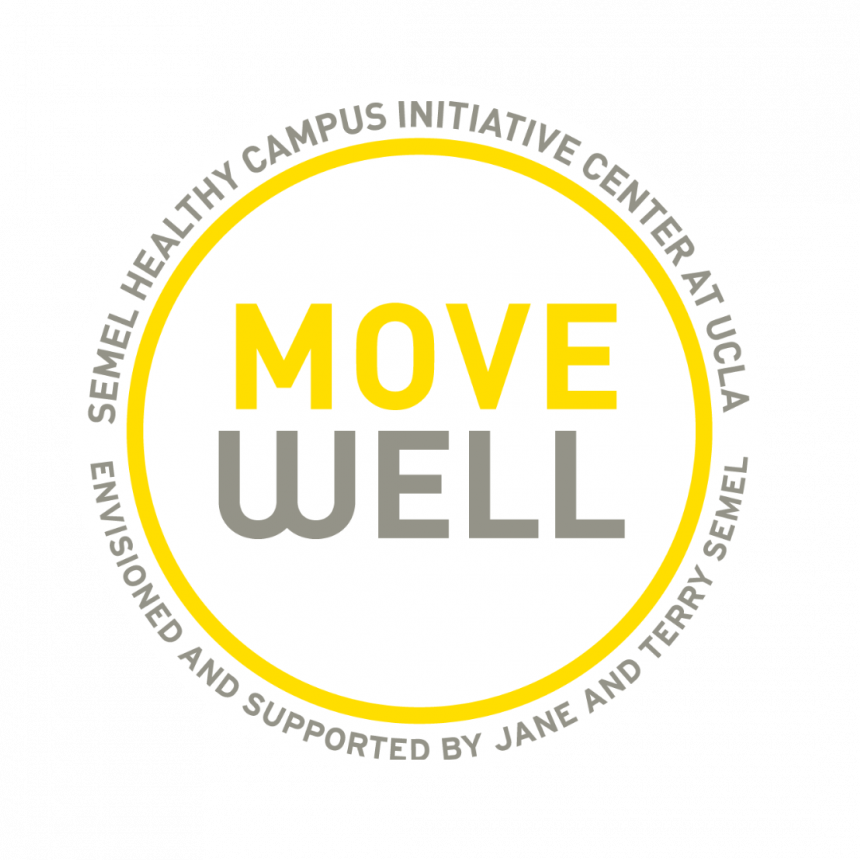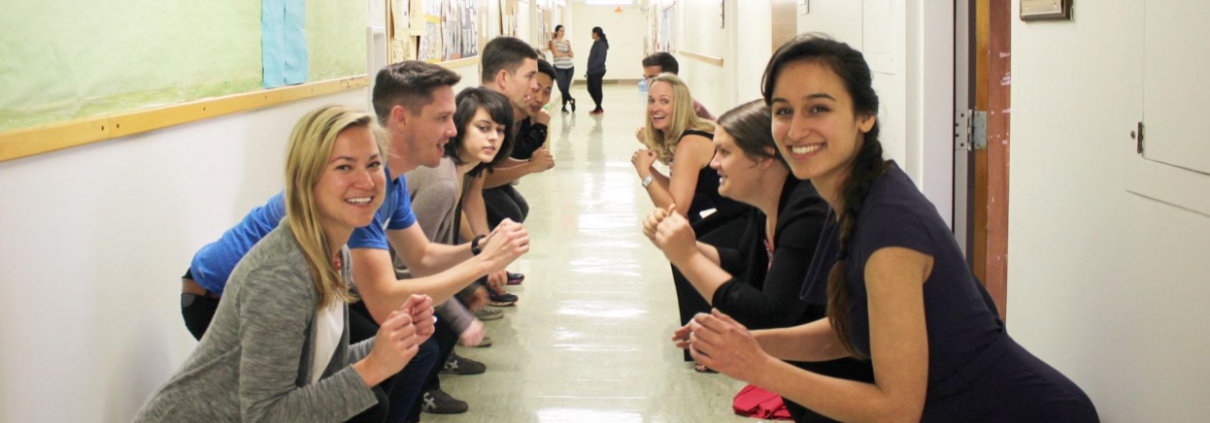Movement Breaks: Choose Your Own Adventure
Hello, my Bruin Fitness Pals!

Photo via Tiffany Hu
Do you ever feel that some classes are just way too long and you need a break? Do you ever feel like sometimes you just can’t stand to sit for any longer, even in those 50 minute classes? Well some amazing professors have a solution for you!

Photo via Dr. Julie Elginer
The Move Well pod was able to interview a professor who has integrated “movement breaks” into her classes: the lovely, Julie Elginer, Dr.PH, MBA, faculty in the UCLA Fielding School of Public Health (pictured above with her two sons). We were able to get the inside scoop on incorporating “movement breaks” in class to help combat the feelings associated with long periods of sitting. They are not mandatory for students, as they can “choose their own adventures”, and just serve to help fight a sedentary lifestyle.
To get you all well-versed on “movement breaks”, here are some questions we asked Dr. Elginer to learn more about what they are.
Question: Could you please explain what movement breaks are?
Dr. Julie Elginer (JE): They are an opportunity to incorporate short, active sequences (5-7 minutes) into the class structure to break up extended sitting periods.
Q: When did you start including movement breaks into your class? Is this the first quarter or have you been doing this for some time?
JE: I am a product of Dr. Toni Yancey in that I was a doctoral student when she was actively publishing and practicing her work on Instant Recess. While my doctoral research did not focus on the issue, I observed the impact it had on reducing sedentary practices and improving health outcomes. I am in my sixth year of teaching at FSPH. I started incorporating movement breaks during my first quarter in Winter 2012 while I was pregnant with my second child.
Q: How do you come up with ideas for your movement breaks?
JE: I incorporate elements of my own personal workouts. For example, I will offer them a chance to do a “plank challenge.” During this, you plank for 10 seconds per day, adding 10 seconds for each day of the month. On Day 1, you plank for 10 seconds, on Day 12 for 120 seconds, etc. I’ve done as much as 4 minutes with my class. Nearly a dozen students participated. Not all of the movement breaks are that intense. Sometimes we will hold a few yoga poses with some deep breathing.
Q: How much do you think your students enjoy these breaks and why?
JE: I think they love them, as evidenced by the fact that (a) it brings together students who may not naturally gravitate towards one another, (b) students inquire what we will do each day, and (c) different groups of students participate each week. Last year, the students created a Facebook group to share photos of themselves continuing the plank challenge outside of class. They found it motivational and fun.
After we learned a bit more on what movement breaks entail, in addition to interviewing Dr. Elginer, we got to check out one of their movement breaks and interview four of her amazing students (all pursuing Masters in Public Health, concentrating in Health Policy and Management) on their thoughts and feelings for the breaks!

Photo via Tiffany Hu
Q: (To graduate students) What were your initial thoughts to the movement breaks?
Allen Taing (AT): Loved them! Really looked forward to them and it’s hard to find time to work out so it’s nice that she integrates them into her class!
Eesha Jagtap (EJ): I heard about movement breaks during orientation, when the John Wooden Center came to speak. I thought the break was great because orientation is about 6 to 7 hours. I told them there that they should definitely come to all of my classes. I really like it! And Dr. Elginer is super active and encourages us to do these.
Q: Do you think that this has improved either your class time or your life? If so, why?
Dr. Elginer (JE): My classes are intense, generally 3 hours each. I teach topics that require students to “move outside of their comfort zones” with Healthcare Financial Management (HPM 436), Reproductive Health Advocacy (CHS M430) and, to a lesser extent, Healthcare Marketing (HPM 445). My classes are skills based and require students to produce deliverables that replicate what they will be expected to do for employers. I have high expectations for them and their work quality because I want to provide feedback to prepare them for internships and full time roles. I recognize this is difficult, at times. I would like to think that by incorporating movement breaks and demonstrating that faculty can have fun alongside students, it breaks down barriers.
Bryan Keyes (BK): This has improved my class time because it engages our diffused memory system instead of focused memory system. In focused memory systems, we are actively thinking about what is presented to us and trying to store that short term memory. When we switch to diffuse, by doing things that are less mentally taxing (such as moving), we refresh our minds.
Andrew Lowberg (AL): Yes! I am a runner and exercise regularly, so these breaks are a nice way to change up the pace and do something different. I have also heard that my classmates have adopted some of the workout challenges to do on their own.
AT: It created an atmosphere for bonding within our class and it was great seeing my classmates encourage each other to hold on for another half minute or push for one more squat. It’s a short time to destress, get more oxygen into our brains, and I know it definitely helped me come back to the material refreshed — which has motivated me to incorporate more movement breaks into my studying outside class.
Q: Would you recommend that other teachers incorporate these types of breaks in their classrooms?
JE: Definitely. I realize that space is an issue. I’ve incorporated breaks into the classroom and the hallway. We try to be mindful of open doors so as to minimize disruptions. I’ve actually had people come into the hall to see what we are up to. I love talking to them about it. We haven’t had anyone join us yet, but I’m making it my goal to do so.
EJ: Yes, we are a public health program and we need to be aware of health. Even though we do get a short break during long classes, I think intentional breaks for physical activity are necessary, and people can decide whether or not to participate.
Q: What are your thoughts on the statement “sitting is the new smoking”? And do you think that movement breaks could help with that?
BK: The adverse health effects of sitting are similar to smoking. Both shorten your life expectancy significantly. Both share a co-morbidity. Movement breaks can change that because we re-engage our body and restart the negative effects of sitting.
AL: I totally agree. Increased technology use has led to us sitting while doing most of our work and studying. In my previous job before starting graduate school at UCLA, I had a sit/stand desk and often chose to stand as I feel it greatly increased my productivity. In a time when we are all busy and overwhelmed with work, it is great to have a break for a quick workout.
Q: What is movement to you and do you believe movement is important to daily life?
JE: I like to say to my students, “This isn’t the School of Sedentary Living. This is the School of Public Health.” If we are creating policies to promote population level health, we need to model it.
AT: I came from a life science background and I think it’s amazing how many components need to work together in order for us to move. Overall, I think movement is a big blessing and a joy.
EJ: Movement is any activity that increases your heart rate. As a child, I played sports so I never viewed that as exercise but as an adult, when I spend 80% of my day sitting, I have never valued movement more.
BK: Movement is incredibly important. I made sure that my apartment was walking distance to campus because I wanted to make sure I was moving every day. Just look at what has happened to humans over the past 200 years. Since the invention of the car, combined with the shift of american labor moving from manufacturing to professional jobs, we must take more action to move ourselves.
Now that we gave you all the inside scoop on these movement breaks: to undergraduates and graduates, would you want them incorporated in your classes? A few other professors have already started adding them into class and with more positive feedback, we’ll be able to entice more into including them! We hope you all are as excited about these movement breaks as we are!
Ttll us and tell your professors your opinions on these as well! Let us know your thoughts and feelings about them in the comments or email us!
As always, keep moving, my Bruin Fitness Pals!
Tiffany Hu is an undergraduate student at UCLA majoring in Microbiology, Immunology, and Molecular Genetics. She is a blogger for Move Well of the UCLA Healthy Campus Initiative. She is the co-Director of the Student Health Advocates, which focuses on educating students on various intersections of health. Tiffany is also the Special Projects and Alumni Coordinator of the UCLA Care Extender Internship, which helps students volunteer at all departments in the UCLA Medical Centers.



